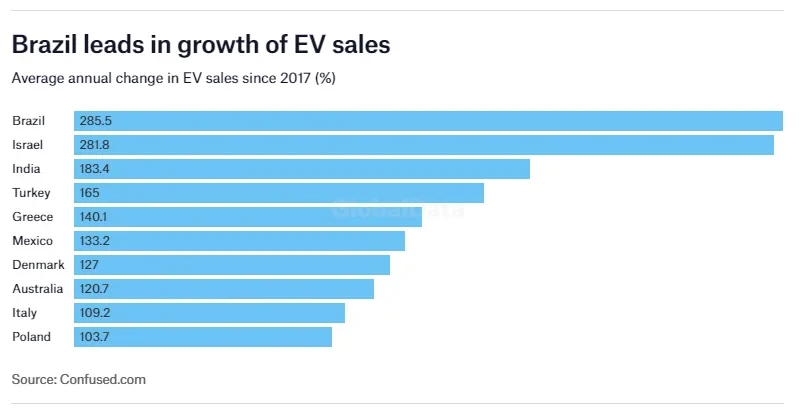The balance has tipped away from combustion engines and towards the EV market, but lagging infrastructure is stalling the shift.

The demand for internal combustion engine (ICE) vehicles has experienced its peak, according to industry experts, making way for the electric vehicle (EV) market, which looks set to grow in line with the developing battery market. However, the industry will be constrained by the limited availability of charging stations and slow installation processes.
The shift away from ICEs is already firmly underway, with the EV market experiencing massive international growth. Confused.com car insurance compared the annual change in EV sales since 2017 globally, noting the top ten countries have all seen growth rates of over 100%. Brazil topped the list with a 285.5% annual growth in EV sales, while Israel and India followed with 281.8% and 183.4%, respectively.

The EV “tipping point”
David Leah, Senior Analyst at GlobalData’s Powertrain team, considered this market shift towards EVs: “It’s not going to happen overnight and there remain a number of risks that could slow the transition down. That said, considering external and industry trends, the shift to zero-emission vehicles seems inevitable.”
This “inevitable” shift is being driven by automakers’ increasing commitment to electrification, incentivised by government policies. In Europe, these include the EU’s CO2 emissions regulation for cars and vans, whilst in China, the New Energy Vehicles (NEV) mandate assigns credits to vehicles depending on electric range, energy efficiency, and rated power of fuel cell systems.
China’s model followed California’s Zero-Emission Vehicle (ZEV) program, which requires large-volume and intermediate-volume vehicle manufacturers to ensure that a certain proportion of their sales are plug-in hybrid EVs or zero-emission vehicles.
With 10 million electric vehicles on the road globally in 2020, this change in approach by manufacturers has already translated into a shift in consumer purchasing habits, as companies are seeing sales reflect the move away from ICEs. BMW’s Chief Financial Officer Walter Mertl’s stated this week that: “The tipping point for combustion engines was last year … Future volume growth will primarily come from battery electric vehicles.”
Jordan Roberts, battery raw materials analyst at Fastmarkets, noted the recent Go Zero Charge survey of 1,200 UK adults which found that more than 93% would not go back to driving an ICE vehicle. Considering the implications of the shift, he seconded Mertl’s point, saying: “We absolutely have reached a tipping point in the move from combustibles to electric vehicles.”
Solid-state batteries are driving the EV market
Innovation in the battery sector is proving to be a driving factor for the EV industry, as rapid charging and longer driving ranges offer manufacturers a competitive edge.
John Ellmore, Editor of Electric Car Guide, explained: “Solid-state batteries represent the next frontier in battery technology, offering numerous advantages over traditional lithium-ion batteries. With higher energy densities, they promise longer driving ranges, addressing one of the key consumer concerns about EVs – range anxiety.”
Toyota is proving to be a leader in this new technology. The company recently announced a new battery electric vehicle factory, due to begin production of new models in 2026. Models will use Toyota’s solid-state lithium-ion batteries, which have a solid electrolyte to enable the faster movement of ions, supporting rapid charging and discharging.
Ellmore explained the significance of the company’s recent advancements in battery technology: “Toyota is on the verge of launching two versions of a solid-state battery, one offering an impressive range of 621 miles and another even surpassing 745 miles. This isn’t just an incremental improvement, it’s a colossal leap forward.”
The obstacles faced by the EV market
The move towards EVs might have reached “the tipping point,” but the industry’s growth is already facing a myriad of obstacles. These include EV price premiums, unreliable charging networks, and slow growth in charging infrastructure, with the latter set to be a particular pain point for the industry.
In the UK, the government is looking to deploy 300,000 public EV charging points by 2030. However, the ambitious goal is complicated by the practicalities of installation.
Asif Ghafoor, CEO of the national charge network Be.EV, explained: “In order to get closer to the government’s 2030 target of 300,000 public chargers we need to install 110 chargers a day compared to the current rate of 40 a day. This is a complex problem to solve, as it’s not just down to charger supply – every link in the chain is doing something wrong.
“Landowners are slowing the process down, sitting on their land and not giving it up for charging hubs. The way people recharge their car should look more like charging your phone than filling up at the pump. It needs to fit into your lifestyle – charge the car whilst you’re at the gym or the supermarket – and landowners are reluctant to modify their car parks to fit this vision.”
Leaders and laggards in EV technology
Despite infrastructural challenges, some companies have emerged as leaders in the EV market. Sammy Chan, Manager of Automotive Sales Forecasts at GlobalData, identified BYD and Tesla as companies which have seen particular success, while Mazda, Subaru and Suzuki have struggled.
Chan explained why the laggards have faced problems: “The majority of their sales are not in China, or their focus is on regions where legislation towards EV sales is not happening as quickly as it is in Europe, for example.”
Source from Just Auto
Disclaimer: The information set forth above is provided by just-auto.com independently of Chovm.com. Chovm.com makes no representation and warranties as to the quality and reliability of the seller and products.




